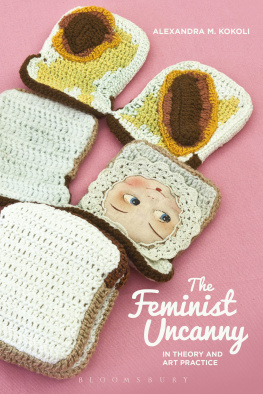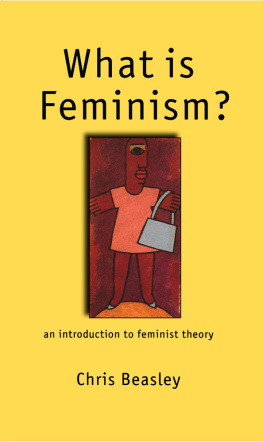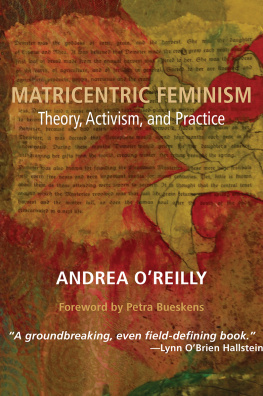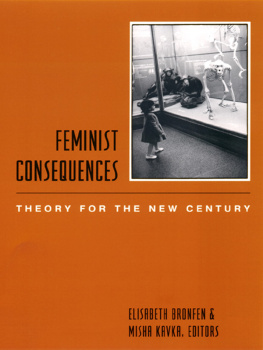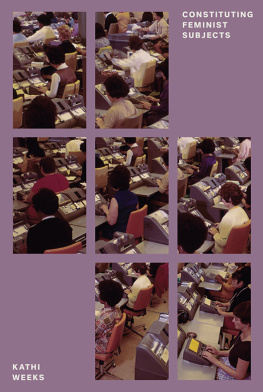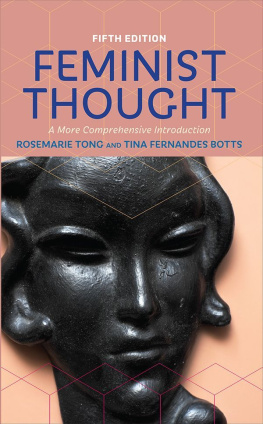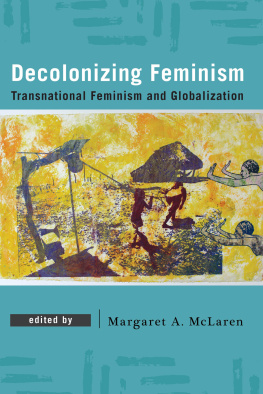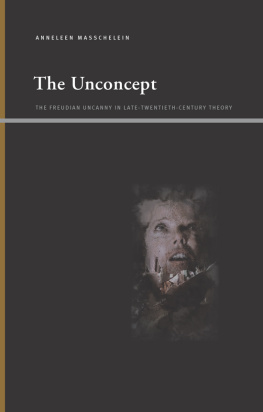The Feminist Uncanny in Theory and Art Practice
Also available from Bloomsbury
Feminist Theory, Fourth Edition , Josephine Donovan
Feminist Theory After Deleuze , Hannah Stark
Listening to Noise and Silence , Salome Voegelin
The Trouble and Strife Reader , edited by Deborah Cameron and Joan Scanlon
The Feminist Uncanny in Theory and Art Practice
Alexandra M. Kokoli
Bloomsbury Academic
An imprint of Bloomsbury Publishing Plc

Contents
Coin with a Gorgons Head, 550-546 BCE, Athens. Courtesy of the British Museum.
Lorraine OGrady, Untitled (Mlle Bourgeoise Noire Beats Herself with the Whip-That-Made-Plantations-Move) , 198083/2009. Silver gelatin fibre print in 13 parts. 9 11/16 in. x 7 1/2 in. Courtesy Alexander Gray Associates, New York. 2014 Lorraine OGrady / Artists Rights Society (ARS), New York.
Lorraine OGrady, Untitled (Crowd Watches Mlle Bourgeoise Noire Whipping Herself) , 198083/2009. Silver gelatin fibre print in 13 parts. 9 11/16 in. x 7 7/8 in. Courtesy Alexander Gray Associates, New York. 2014 Lorraine OGrady / Artists Rights Society (ARS), New York.
Lorraine OGrady, Untitled (Mlle Bourgeoise Noire Shouts her Poem) , 198083/2009. Silver gelatin fibre print in 13 parts. 9 5/8 in. x 6 1/2 in. Courtesy Alexander Gray Associates, New York. 2014 Lorraine OGrady / Artists Rights Society (ARS), New York.
Susan Hiller, Sisters of Menon , 1972/79, installation view. Blue pencil, typescript and gouache on paper. Courtesy of the artist.
Susan Hiller, Sisters of Menon , 1972/79, Analysis of the Relationship between Automatism and Creativity. Blue pencil, typescript and gouache on paper. Courtesy of the artist.
Susan Hiller, Sisters of Menon , 1972/79, automatic writing, page 8. Blue pencil, typescript and gouache on paper. Courtesy of the artist.
Susan Hiller, Midnight, Tottenham Court Road , 1982. C-type prints enlarged from handworked photobooth images. Courtesy of the artist.
Susan Hiller, The Last Silent Movie , 2007. Single-channel projection with sound, 20 mins, installation view. Courtesy of the artist.
Susan Hiller, The Last Silent Movie , 2007. 25 etchings. Plate 7 Khallam, They are lying to us. Courtesy of the artist.
Louise Bourgeois, Femme Maison , 194647. Ink on linen. 36 x 14"; 91.4 x 35.6 cm. Private Collection; Photo: Christopher Burke. The Easton Foundation/Licensed by DACS, London.
Robin, Weltsch, The Kitchen, installation view, Womanhouse , 1972. Courtesy of the California Institute of the Arts Institute Archive.
Faith Wilding, Crocheted Environment, installation view, Womanhouse , 1972. Courtesy of the artist.
Robin Schiff, Nightmare Bathroom, Womanhouse , 1972. Courtesy of the California Institute of the Arts Institute Archive.
A Portrait of the Artist as a Housewife, c.1977. Black-and-white publicity poster, 21 x 29.5 (A4). Feministo: Portrait of the Artist as a Housewife , Womens Art Library/MAKE, London.
Su Richardson, Burnt Breakfast and Packed Lunch , 197576, crochet and mixed media. Feministo: Portrait of the Artist as a Housewife . Photograph by Susan Richardson, 2010. Susan Richardson. All Rights Reserved, DACS 2015.
Kate Walker, Keep Smiling Chocs , c.197577, mixed media in chocolate box, Feministo: Portrait of the Artist as a Housewife . Photograph by Michael Ann Mullen. Courtesy of the artists estate and Michael Ann Mullen.
Kate Walker, Black Magic Bodies , c.197577, mixed media in chocolate box, Feministo: Portrait of the Artist as a Housewife . Photograph by Michael Ann Mullen. Courtesy of the artists estate and Michael Ann Mullen.
Judy Chicago, The Dinner Party , 197479, installation view. Judy Chicago. ARS, NY and DACS, London 2015.
Judy Chicago, Kali place setting from The Dinner Party , 197479. Judy Chicago. ARS, NY and DACS, London 2015.
Judy Chicago, Georgia OKeeffe place setting from The Dinner Party , 197479. Judy Chicago. ARS, NY and DACS, London 2015.
Mary Beth Edelson, Some Living American Women Artists/Last Supper, 1972. Cut-and-pasted gelatin silver prints with crayon and transfer type on printed paper with typewriting on cut-and-taped paper, 28.25 x 43 (71.8 x 109.2 cm). The Museum of Modern Art, New York. Courtesy of the artist.
Sutapa Biswas, Housewives with Steakknives , 1985. Oil, acrylic and pastel on paper and canvas. Collection of Bradford Museums and Galleries.
Jo Spence, Eight and a half months (High street photographer Woodford) & Five hundred and twenty-eight months later, The Family Album 193979 , 1979. Estate of Jo Spence. Courtesy of Richard Saltoun Gallery.
Jo Spence, Phototherapy Sessions with Rosy Martin: Transformations, c.1984, Picturing my dead parents. Estate of Jo Spence. Courtesy of Richard Saltoun Gallery.
Marie Yates, The Only Woman , 1985. Section 1. Rage, 4 panels (detail). Photograph by the artist. Courtesy of the artist.
Marie Yates, The Only Woman , 1985. Section 2. Pain, 10 panels (detail). Photograph by the artist. Courtesy of the artist.
Marie Yates, The Only Woman , 1985. Section 3. Gaze, 6 panels. Photograph by the artist. Courtesy of the artist.
May Stevens, Rosa Alice: Ordinary/Extraordinary , 1977, collage and mixed media. Courtesy of RYAN LEE, New York.
Maud Sulter, Jeanne: A Melodrama , 2002, collage on four panels, panel 1 of 4. Courtesy of the Maud Sulter Archive.
Maud Sulter, Jeanne: A Melodrama , 2002, collage on four panels, panel 2 of 4. Courtesy of the Maud Sulter Archive.
Freddie Robins, Ethel Knitted Homes of Crime , 2002. Knitted wool, quilted lining fabric, 260 x 180 x 160mm. Handknitted by Jean Arkell. Photograph by Douglas Atfield. Courtesy of the artist.
Monica Ross, Ghost in the Spinning Mill performance, Rochdale Gallery, 1985. Original photograph by Patsy Mullan, scanned and processed by Bernard G. Mills. Courtesy of the Monica Ross Archive and Bernard G. Mills.
Monica Ross, Ghost in the Spinning Mill performance, Rochdale Gallery, 1985. Original photograph by Patsy Mullan, scanned and processed by Bernard G. Mills. Courtesy of the Monica Ross Archive and Bernard G. Mills.
I wish to thank the Art & Design Research Institute (ADRI), Middlesex University, whose financial support reduced my teaching load in 201415, allowing me to complete this book. I am especially grateful to Dr. Valeria Graziano of ADRI for her assistance towards organizing and securing permissions for illustrations. I would also like to thank the Association of Art Historians (AAH) for their financial award towards licensing and reprographic costs, without which The Feminist Uncanny would have included far fewer illustrations.
For permission to reproduce some previously published material, I am grateful to KT Press and Tate Publishing. I also wish to thank the artists whose work is reproduced here and their representatives for their support of this book project.
I have shared ideas that culminated in The Feminist Uncanny at various stages of development with colleagues past and present and a variety of international academic audiences and discussants, whom I thank for their feedback, encouragement and occasional reality check. Professors Deborah Cherry and Elena Gualtieri successfully introduced me to the ways of scholarship and academic writing some years ago, despite some resistance on my part; I thank them for their expert guidance and persistence. My gratitude also goes to all the anonymous peerreviewers who have engaged with my work, for their unpaid and largely invisible labour.

